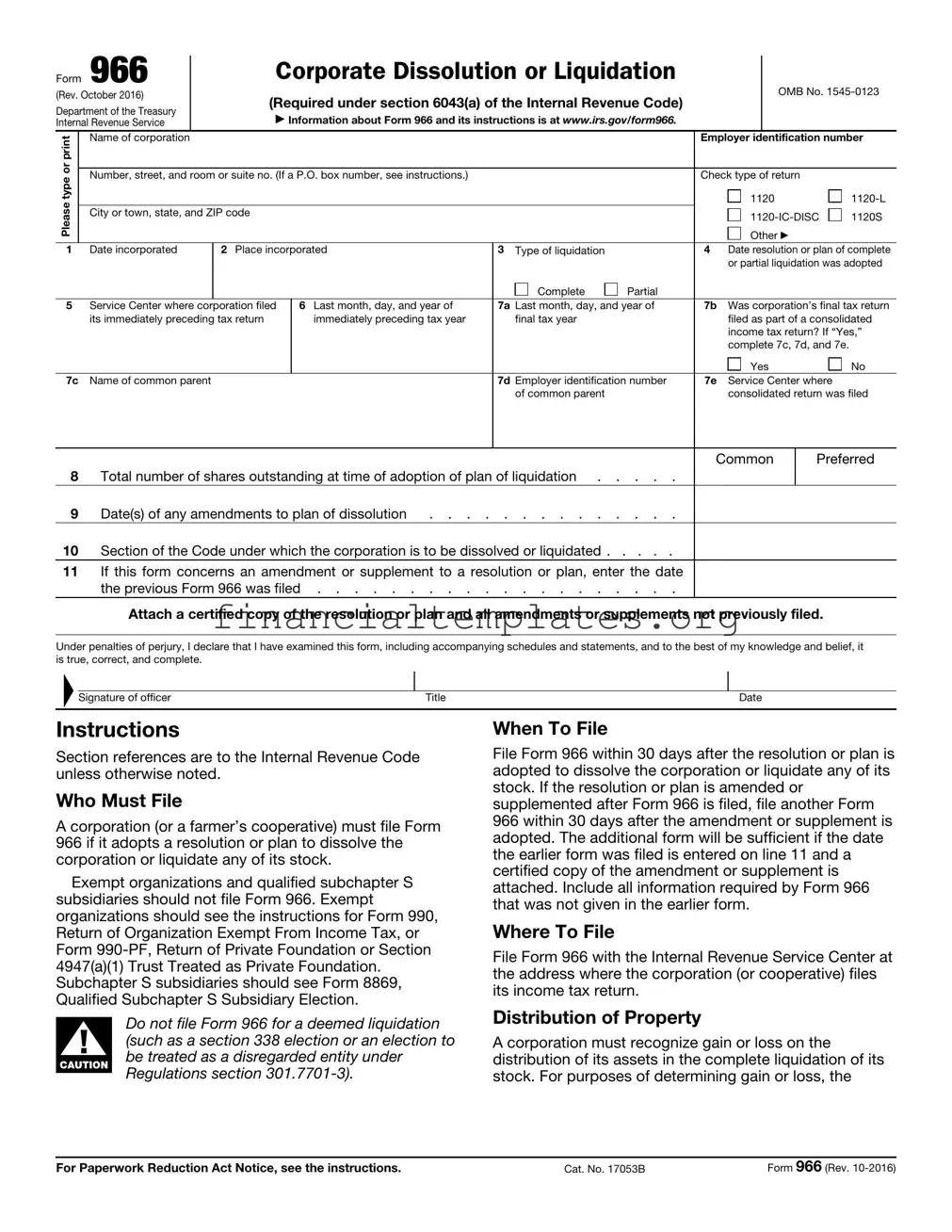The IRS 966 form, required for corporate dissolution or liquidation, bears similarity to several other documents in the realm of business and taxation. When a corporation decides to dissolve, the IRS 966 form becomes a crucial part of the process, ensuring the IRS is informed about the company's decision to cease operations and liquidate its assets. This action bears resemblance to other forms and legal documents used for various purposes related to business activities, taxation, and legal notifications.
One such document comparable to the IRS 966 is the IRS Form 1120, the U.S. Corporation Income Tax Return. Both forms are integral to corporate tax obligations; while Form 966 notifies the IRS of a corporation's dissolution, Form 1120 is used annually to report the corporation's income, gains, losses, deductions, and credits. Each plays a pivotal role in the life cycle of a corporate entity, tracking its financial responsibilities to the government.
Similarly, the IRS Form 8832, Entity Classification Election, shares functionality with the IRS 966. Form 8832 allows an entity to elect how it will be classified for federal tax purposes, a decision that can significantly impact the entity's tax obligations and liabilities. Like the IRS 966, it involves strategic decisions about the company’s tax status, albeit from a different point in the entity's lifecycle.
The Statement of Dissolution (Form LLC-3) in many states mirrors the purpose of the IRS 966. While the IRS form is for federal notification, the LLC-3 form is usually filed with a state's secretary of state to officially dissolve a limited liability company. Both documents are crucial for legally ending the operations of a business entity and ensuring compliance with federal and state laws.
The Articles of Dissolution is another document utilized when a corporation decides to terminate its existence officially. Like the IRS 966, it's filed with the state government and serves as a formal announcement of the company's decision to dissolve. This document ensures that the state acknowledges the corporation's end and its obligations come to a close.
Form 8594, Asset Acquisition Statement, while used in a different context, is related to the dissolution process. When a business is sold, Form 8594 is used to report the sale of business assets, which can be part of the liquidation process covered by IRS Form 966. Both forms deal with the transfer or liquidation of business assets, though in different circumstances.
The IRS Form 5472, Information Return of a 25% Foreign-Owned U.S. Corporation or a Foreign Corporation Engaged in a U.S. Trade or Business, though focusing on international aspects, shares the theme of corporate entities reporting significant financial information to the IRS. Like Form 966, it's a disclosure to the IRS but focuses on transactions with foreign-related parties.
Form 5500, Annual Return/Report of Employee Benefit Plan, also intersects with the IRS 966 in the broader sense of reporting obligations of entities. This form reports information about employee benefit plans, which might be terminated or significantly altered as part of the corporate dissolution process reported via Form 966. Both forms ensure compliance with federal regulations, though they focus on different aspects of the business.
Lastly, the IRS Form 990, Return of Organization Exempt from Income Tax, is somewhat analogous to the IRS 966. While the 990 is for nonprofit organizations to report their annual financial information, the essence of reporting financial activities to the IRS aligns with the intention behind Form 966. Both are critical for maintaining transparency and compliance with federal regulations, albeit for different types of entities.
In conclusion, while the IRS 966 form has a unique purpose in the corporate dissolution process, its foundational goals of ensuring compliance, reporting financial information, and notifying federal or state authorities resonate through several other forms and documents. Each plays a distinct role in the lifecycle and management of business entities, reflecting various stages and aspects of corporate and tax responsibilities.

